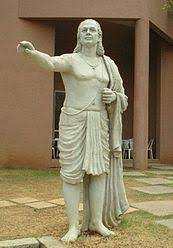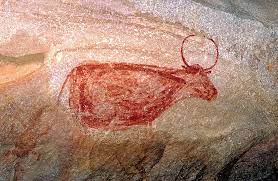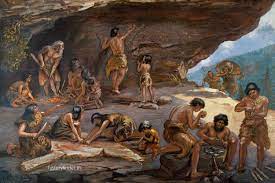The ancient history of Bihar is rich and varied. The region has been home to many empires and dynasties over the centuries, including the Magadha Empire, the Mauryan Empire, the Gupta Empire, and the Pala Empire.

Table of Contents
Paleolithic Period in Bihar
The earliest evidence of human habitation in Bihar dates back to the Paleolithic period (c. 500,000 BC). Bihar has one of the richest Paleolithic heritages in India. The region has yielded a wide range of stone tools, including hand axes, cleavers, choppers, and scrapers. These tools were made from a variety of materials, including quartzite, and basalt.
The Paleolithic people of Bihar were hunter-gatherers. They lived in small bands and moved around in search of food and water. They hunted animals such as deer, antelope, and wild boar. They also gathered fruits, vegetables, and nuts.

The Paleolithic people of Bihar lived in a variety of environments, including forests, grasslands, and river valleys. They built simple shelters from branches and leaves. They also used caves and rock shelters for protection from the elements.

The Paleolithic period in Bihar came to an end around 10,000 BC. This was due to a number of factors, including climate change and the development of new technologies. The Paleolithic people of Bihar were gradually replaced by the Mesolithic people, who were more advanced hunter-gatherers.
Evidences from Chirand
The most important pre-historic site in Bihar is Chirand. Chirand is a multi-layered archaeological site that has revealed evidence of continuous human habitation from the Neolithic period to the present day. Excavations at Chirand have unearthed a variety of artifacts, including stone tools, pottery, and animal bones. These artifacts provide valuable insights into the lives of pre-historic people in Bihar.

Excavation at Chechar
The excavation at Chechar, Vaishali, Bihar, India, was conducted by the Archaeological Survey of India (ASI) in 1988-89. The excavation revealed a number of important findings, including:
- A well-preserved brick house
- A variety of pottery, including black polished ware (NBP)
- Punch-marked coins
- Iron tools
- Terracotta figurines
- A Buddhist stupa
- A terracotta figurine of Helen, daughter of one of Alexander’s commanders
The findings from the excavation at Chechar suggest that the site was occupied from the 6th century BC to the 2nd century AD. The site was likely a major center of trade and commerce during this period. The presence of the Buddhist stupa and the terracotta figurine of Helen suggest that the site was also a center of Buddhism and Hellenism.

The excavation at Chechar is an important archaeological discovery. It has shed new light on the early history of Bihar and the development of trade, commerce, and religion in the region.
The findings from the excavation at Chechar are also significant because they provide evidence of cultural contact between India and the West during the 4th century BC. The terracotta figurine of Helen suggests that the people of Chechar were familiar with Greek culture. This is likely due to the invasion of India by Alexander the Great in 326 BC.
The excavation at Chechar is an important contribution to our understanding of the early history of Bihar and India. It has shed new light on the development of trade, commerce, religion, and culture in the region.
Mesolithic Period in Bihar
The Mesolithic people of Bihar lived in the region from around 10,000 BC to 4,000 BC. They were more advanced hunter-gatherers than the Paleolithic people who had preceded them. The Mesolithic people of Bihar developed new technologies, such as the bow and arrow, which allowed them to hunt more efficiently. They also began to domesticate animals, such as dogs and goats.

The Mesolithic people of Bihar lived in a variety of environments, including forests, grasslands, and river valleys. They built simple shelters from branches and leaves. They also used caves and rock shelters for protection from the elements.
The Mesolithic people of Bihar left behind a variety of artifacts, including stone tools, pottery, and rock paintings. The rock paintings of the Mesolithic people of Bihar are particularly well-known. They depict a variety of scenes, including hunting, dancing, and religious ceremonies. The Mesolithic period in Bihar came to an end around 4,000 BC. This was due to a number of factors, including the development of agriculture and the rise of permanent settlements.
The Mesolithic people of Bihar played an important role in the development of Indian culture and civilization. The Mesolithic people of Bihar also left behind a variety of artifacts, including stone tools, pottery, and rock paintings, which provide us with insights into their way of life.
The Mesolithic people of Bihar were gradually replaced by the Neolithic people, who were the first farmers in the region.
Neolithic History of Bihar
The Neolithic period in Bihar lasted from around 4,000 BC to 1500 BC. It was during this period that the first farmers arrived in the region. The Neolithic people of Bihar cultivated crops such as rice, wheat, and barley. They also domesticated animals such as cattle, sheep, and goats.

The Neolithic people of Bihar lived in permanent settlements. They built houses from mud and thatch. They also built granaries to store their crops. The Neolithic people of Bihar developed new technologies, such as pottery and weaving. They also made tools from stone and metal.
The Neolithic period in Bihar came to an end around 1500 BC. This was due to a number of factors, including the development of new agricultural technologies and the rise of urban centers. The Neolithic people of Bihar were gradually replaced by the Chalcolithic people, who were more advanced farmers and traders.
Important features of the Neolithic period in Bihar
- The Neolithic people of Bihar were the first farmers in the region.
- They cultivated crops such as rice, wheat, and barley.
- They also domesticated animals such as cattle, sheep, and goats.
- The Neolithic people of Bihar lived in permanent settlements.
- They built houses from mud and thatch.
- They also built granaries to store their crops.
- The Neolithic people of Bihar developed new technologies, such as pottery and weaving.
- They also made tools from stone and metal.
- The Neolithic period in Bihar came to an end around 1500 BC. This was due to a number of factors, including the development of new agricultural technologies and the rise of urban centers.
The Neolithic people of Bihar played an important role in the development of Indian culture and civilization. They were the first farmers in the region, and they developed new technologies and domesticated animals. The Neolithic people of Bihar also laid the foundation for the development of urban centers in Bihar.
Important sites in Ancient History of Bihar
- Chirand
- Chechar
- Maner
- Taradih
- Barudih
These sites have yielded a variety of artifacts, including pottery, stone tools, and animal bones. These artifacts provide us with insights into the way of life of the Neolithic people of Bihar.
The Neolithic period in the Ancient History of Bihar is an important period in Indian history. It was during this period that the first farmers arrived in the region and developed new technologies and domesticated animals. The Neolithic people of Bihar played a vital role in the development of Indian culture and civilization.
Harappan Civilization in Bihar
The region was also home to the Harappan Civilization (c. 3300-1300 BC), one of the world’s oldest known civilizations.
Harappan pottery has been found at a few sites in Bihar, such as Sonpur and Chirand. This suggests that there may have been trade between the Harappans and the people of Bihar.
Additionally, some of the pottery designs found in Bihar are similar to Harappan pottery designs. This suggests that the people of Bihar may have been influenced by the Harappan Civilization.
However, it is important to note that the evidence for the Harappan Civilization in Bihar is limited. More research is needed to determine the exact nature of the relationship between the Harappans and the people of Bihar.
Some scholars believe that the Harappans may have established trading colonies in Bihar. Others believe that the Harappan Civilization may have influenced the development of the local Chalcolithic cultures in Bihar.
It is also possible that the Harappans never had direct contact with the people of Bihar. The Harappan pottery found in Bihar may have been brought to the region by traders from other regions.
More research is needed to determine the exact nature of the relationship between the Harappans and the people of Bihar. However, the available evidence suggests that the Harappans may have had some contact with the people of Bihar, either directly or indirectly.
Important Kingdom in Ancient History of Bihar
The first major empire to arise in Bihar was the Magadha Empire (c. 600-320 BC). The Magadha Empire was a powerful and prosperous empire, and it ruled over most of northern India. The Magadha Empire was also a major center of culture and learning.
The Mauryan Empire (c. 320-180 BC) was founded by Chandragupta Maurya, a former general in the Magadha army. The Mauryan Empire was the largest empire in Indian history, and it ruled over most of the Indian subcontinent. The Mauryan Empire was also a major center of Buddhism, and it is credited with spreading Buddhism throughout Asia.

The Gupta Empire (c. 320-550 AD) was founded by Chandragupta I. The Gupta Empire was a period of peace and prosperity for India. The Gupta Empire was also a major center of culture and learning, and it is often referred to as the “Golden Age of India.”
The Pala Empire (c. 750-1200 AD) was founded by Gopala I. The Pala Empire was a powerful and prosperous empire, and it ruled over most of eastern India. The Pala Empire was also a major center of Buddhism, and it is credited with spreading Buddhism to Tibet and other parts of Asia.
In addition to these major empires, Bihar has also been home to a number of other dynasties and kingdoms over the centuries. These include the Lichhavi dynasty, the Shunga dynasty, the Kanva dynasty, the Kushan dynasty, the Vardhana dynasty, and the Pala dynasty.
The ancient history of Bihar is a rich and varied one. The region has been home to many empires and dynasties over the centuries, and it has played a major role in the development of Indian culture and civilization.
Thanks for reading the post Ancient History of Bihar.
